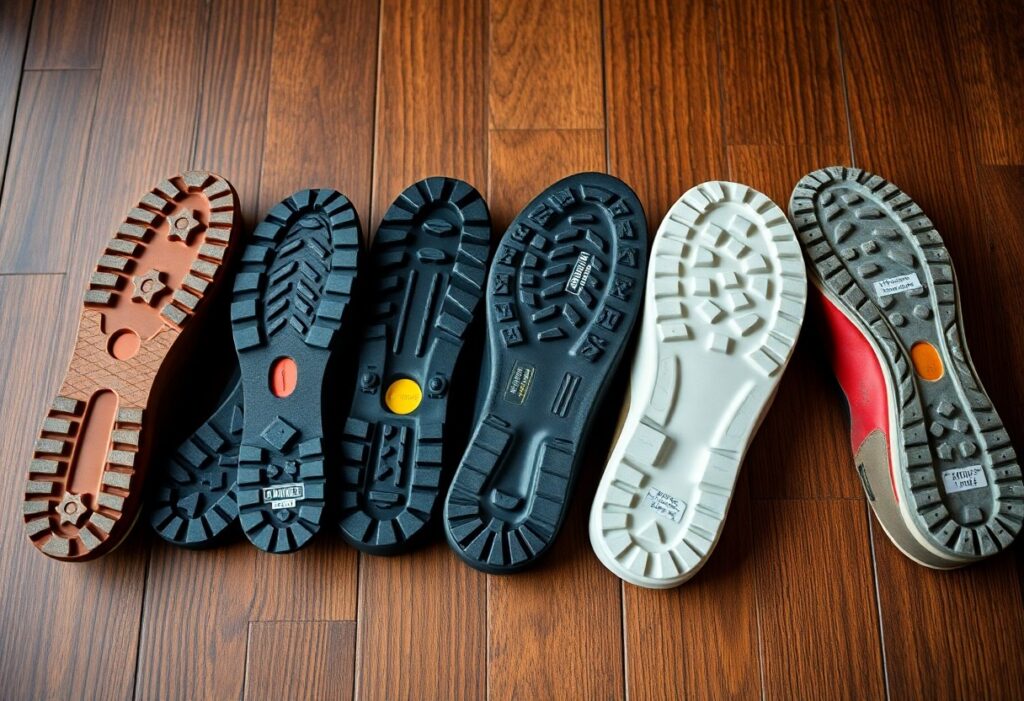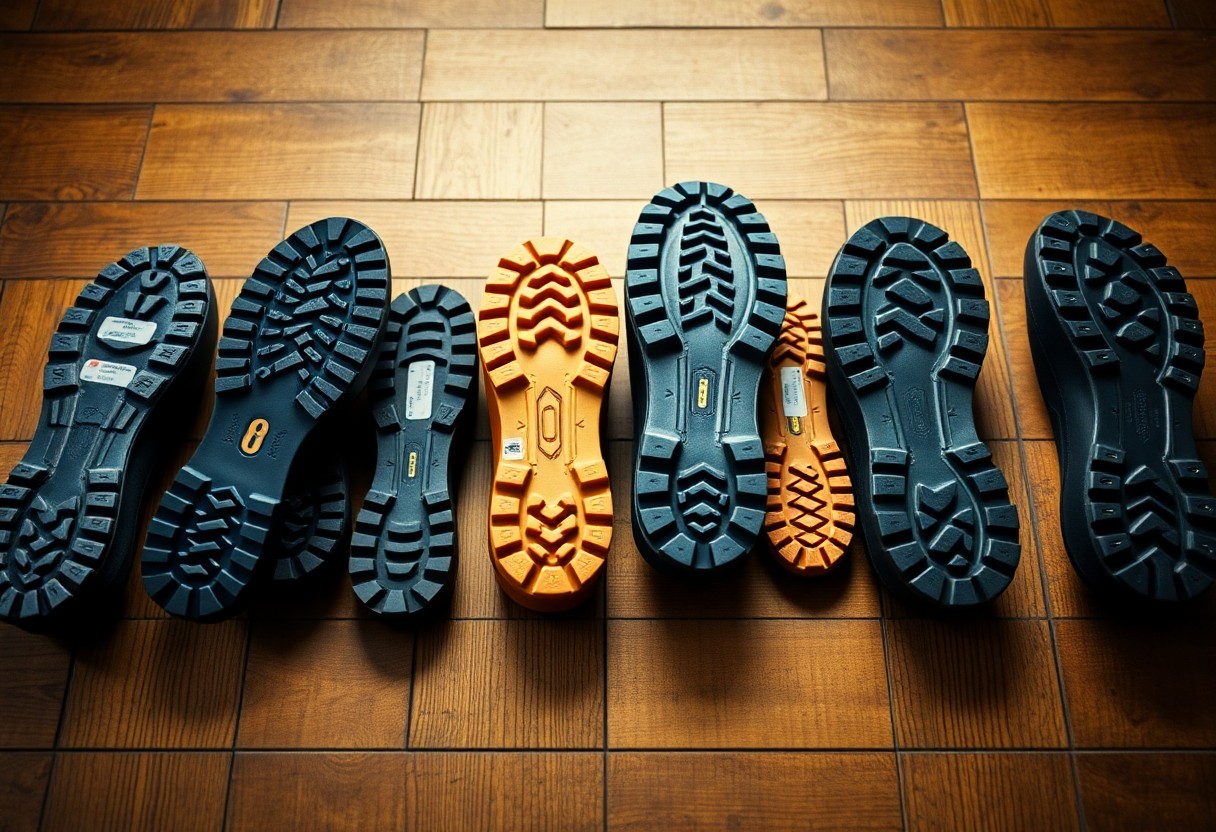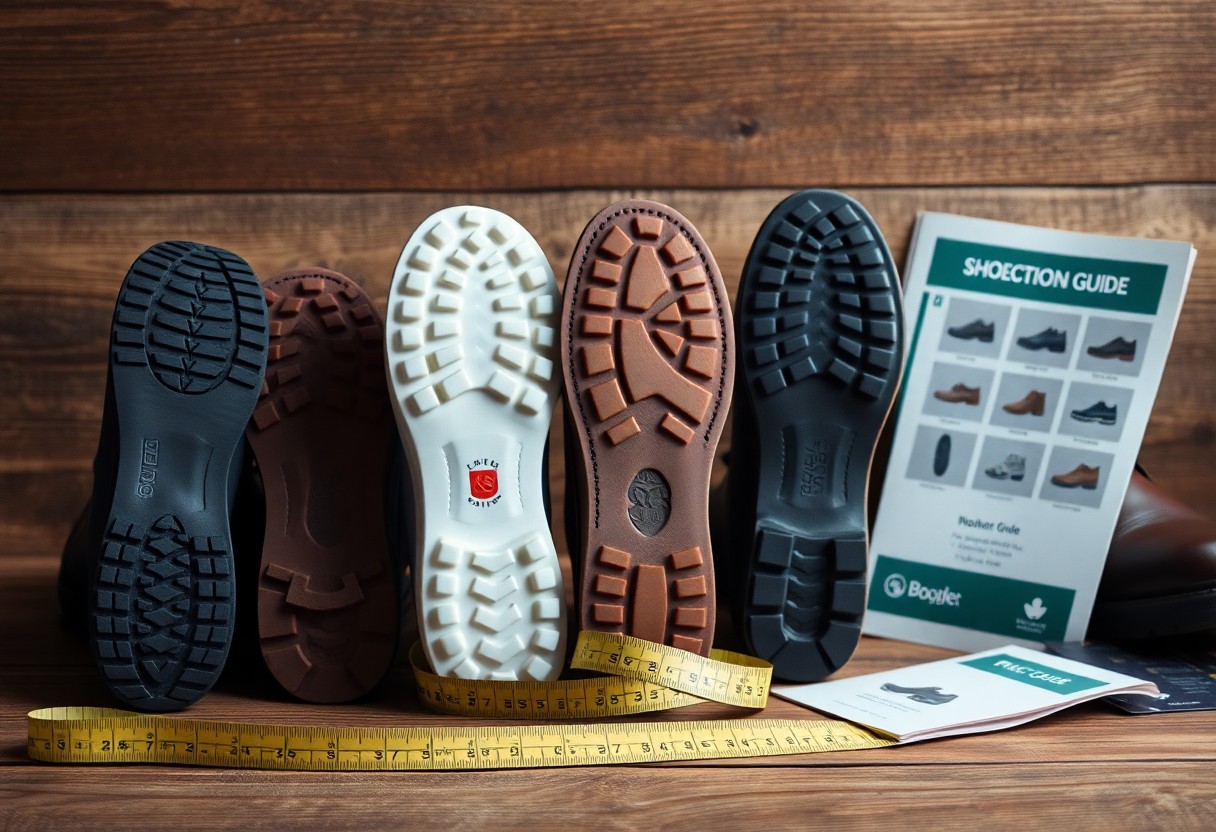
When choosing the right footwear, many people overlook the indispensable role of shoe soles. This crucial element directly impacts your comfort and safety during wear. The sole type you select can determine whether you achieve stable footing on slick surfaces or face the risk of slips and accidents, as well as whether you enjoy long-lasting comfort or encounter premature wear and tear. With options ranging from classic leather to modern rubber compounds, each type of sole offers distinct benefits tailored for specific uses. You can select from single leather, double leather, rubber, and hybrid soles—each expertly designed for various conditions and applications. This extensive guide aims to illuminate the defining features of different sole types and help you make an informed decision that suits your individual needs, whether you're looking for footwear for work, leisure, or outdoor adventures.

Unlock the Advantages of Leather Soles for Superior Footwear Performance
Your choice of leather soles can significantly influence both the character and functionality of your footwear. These traditional soles are celebrated for providing excellent breathability and natural comfort, as they adapt to the shape of your feet over time for a customized fit. Although they do require more maintenance than synthetic alternatives, leather soles offer remarkable ground feel, making them an exceptional option for formal occasions where style is paramount. Understanding the unique benefits of leather soles will empower you to make a well-informed selection, enhancing not just your wardrobe but also your overall walking experience by ensuring comfort and elegance.
Enhance Your Style with Single Leather Soles for Dress Shoes
Soles made from a single layer of leather represent the most traditional choice for sophisticated dress shoes. These soles are crafted to provide extraordinary flexibility and a refined appearance, perfect for elevating your style during formal events. While they offer better breathability compared to rubber options, it's essential to navigate wet conditions with caution to avoid potential damage. By opting for single leather soles, you not only embrace a timeless aesthetic but also enjoy the comfort that accompanies quality craftsmanship, ensuring you look and feel your best.
Boost Your Footwear's Longevity with Double Leather Soles
Double leather soles, featuring two layers of leather, offer enhanced durability and superior insulation against cold surfaces. While they may feel slightly less flexible than single soles, they provide greater protection for your feet in various conditions. This robust design ensures that double leather soles will significantly outlast single soles, making them a smart investment for daily wear. They are especially well-suited for individuals with a heavier build or those who enjoy outdoor activities, although it's important to note that they require a longer break-in period to achieve optimal comfort.
By choosing double leather soles, you are investing in footwear that seamlessly combines durability and performance, ensuring your shoes can withstand the rigors of everyday use while maintaining an elegant appearance.
Maximize Comfort and Support with HAF (Half and Full) Soles
HAF soles, which integrate single leather in the waist and heel with double leather in the forepart, provide you with the best of both worlds. This innovative construction ensures extra durability in high-wear areas while maintaining a sleek and elegant profile. The unique design of HAF soles promotes balanced weight distribution and enhanced comfort, effectively safeguarding critical areas without compromising the shoe’s refined look. However, it is crucial to confirm that your cobbler includes appropriate heel compensation to achieve the best balance for your foot structure.
Explore the Versatility of Natural and Mixed Soles for Everyday Footwear
Natural and mixed soles deliver a versatile blend of comfort and durability. These soles consist of organic materials such as cork, natural rubber, or leather combined with synthetic compounds, resulting in adaptable and high-performing footwear solutions. When selecting from the various natural and mixed soles, consider your specific needs regarding grip, weight, and resistance to environmental conditions. Awareness of these factors will guide you in making an educated choice that aligns with your lifestyle and activities, ensuring your footwear meets your everyday demands.
Discover Lightweight Comfort with Nitrile Cork Soles
In addition to traditional rubber options, nitrile cork soles present a lightweight alternative that maintains impressive durability. These soles, which blend cork with nitrile rubber, are 30% lighter than standard rubber soles, making them highly favored for American shoes and boots where comfort is paramount. Available in both smooth and treaded patterns, nitrile cork soles are ideal for individuals who prioritize lightweight footwear without compromising on performance. By choosing these soles, you can engage in your daily activities with both ease and style.
Enjoy Everyday Comfort with Natural Crepe Soles
Natural crepe soles, made from pure rubber, offer exceptional comfort through their soft, cushioning properties. These soles are particularly well-suited for casual footwear and provide varying degrees of grip depending on the surfaces you encounter. While crepe soles are known for their superior comfort for daily wear, they do have some limitations. Their soft composition results in a wear rate that is approximately 40% faster than traditional rubber soles, and their grip may falter on wet surfaces. Consequently, although many users appreciate the comfort they afford, it's essential to consider the potential need for more frequent replacements to maintain optimal performance.

Unveil the Benefits of Rubber Soles for Unmatched All-Weather Performance
Rubber soles are particularly notable for their superior grip and water resistance when compared to leather soles. These soles excel in wet conditions, making them an ideal choice for everyday wear across diverse weather scenarios. Rubber soles are known for their excellent durability and require less maintenance than leather options, although they may feel warmer on your feet during the hotter months. The practical advantages of rubber soles render them a wise selection for those seeking reliable performance and comfort in their footwear.
Achieve an Ideal Combination with Rubber Topy Soles
Rubber Topy soles represent an exceptional compromise between leather and rubber soles, providing you with the best of both worlds. With these soles, you gain the classic look of leather while enjoying enhanced grip and durability. A thin layer of rubber is cemented onto a slightly sanded leather sole, effectively extending the lifespan of your footwear by up to 50%. This combination allows you to relish the aesthetic appeal of leather without sacrificing practicality, making Rubber Topy soles a smart addition to your footwear collection.
Experience Style and Functionality with City Rubber Soles
By selecting city rubber soles, you can achieve a sleek, dress shoe appearance without compromising on practicality. These thin rubber soles closely mimic traditional leather soles while offering better traction and waterproofing. Increasingly favored in modern dress shoes, city rubber soles not only enhance the visual appeal of your footwear but also improve longevity compared to leather soles, requiring less frequent resoling. Perfect for urban environments, these soles are well-equipped to handle concrete sidewalks and occasional rain, ensuring you remain stylish and comfortable no matter the weather.
Enhance Durability with Dainite and Studded Soles
Among rubber options, Dainite and studded soles provide maximum durability and grip. Their distinctive studded pattern ensures reliable traction while maintaining a formal appearance, making them particularly suitable for business casual footwear and dress boots. While Dainite soles are highly resistant to wear, it's important to recognize that they can become slippery in freezing temperatures. User experiences may vary, as some find them firmer than other sole types. However, for everyday use in moderate conditions, these soles generally outlast traditional leather soles by 2-3 times, making them an excellent choice for durability and performance.
Essential Performance Characteristics of Shoe Soles
Your selection of shoe sole can significantly impact your daily comfort and safety. Different sole types offer varying levels of grip, shock absorption, and flexibility, each fulfilling specific roles that range from preventing slips on slick surfaces to alleviating foot fatigue during extended periods of walking. A comprehensive understanding of these performance features will enable you to select the ideal sole type for your needs, ultimately enhancing your overall footwear experience.
Assess Durability Factors in Sole Materials
The longevity of various sole materials can differ widely in terms of wear resistance. Typically, rubber compounds outlast leather soles by 3-4 times, while nitrile cork serves as a middle ground in this regard. Factors such as material density and tread pattern play significant roles in determining the lifespan of your soles. Being aware of these durability considerations empowers you to make cost-effective footwear choices tailored to your unique lifestyle and activities.
Understand Weather Resistance for Optimal Sole Performance
Aspects such as water resistance, temperature tolerance, and traction are vital in assessing how your soles perform under various conditions. Generally, rubber soles provide superior grip in wet environments, while leather soles excel in dry settings. It's crucial to remember that temperature fluctuations can considerably influence sole performance. Some rubber compounds may become dangerously hard in sub-zero temperatures, while others retain their flexibility. Your local climate should guide your selection: city rubber soles are best for mild wet conditions, whereas specialized winter soles offer enhanced safety in snowy or icy environments.

Your Complete Guide to Selecting the Optimal Shoe Sole
It’s important to recognize that not all shoe soles are created equal; your selection should align with your particular needs and preferences. Choosing the appropriate sole type can greatly influence your comfort, safety, and the longevity of your footwear. This guide is crafted to assist you in identifying the most suitable sole type based on your lifestyle, activities, and environmental conditions.
Factor in Your Daily Activities When Choosing a Sole
When selecting a sole, key considerations include your daily activities and the walking surfaces you commonly encounter. For office environments, thin leather or city rubber soles are ideal. In contrast, industrial settings benefit from thick rubber or studded soles that provide heightened protection. For outdoor activities, it's crucial to focus on grip requirements and durability needs. Understanding your primary usage will aid you in narrowing down the best options available for your footwear.
Evaluate Climate Factors for Optimal Sole Performance
In addition to weather conditions, fluctuations in temperature can have a significant effect on the performance of shoe soles. Here are some vital considerations:
- Wet conditions – rubber soles deliver superior grip
- Cold weather – thicker soles provide better insulation
- Hot climates – breathable leather soles are optimal
- Variable weather – hybrid soles offer versatility
Awareness of your local climate patterns is essential to selecting the most appropriate sole type for your footwear.
Moreover, it’s important to consider how different sole materials react to varying weather conditions:
- Leather soles necessitate special care in wet environments
- Rubber soles can become very hard below 0°C
- Nitrile cork offers a good balance in moderate conditions
- City rubber soles provide year-round versatility
Being cognizant of these characteristics ensures your footwear will perform effectively in any season.
Vital Maintenance and Care for Longevity of Shoe Soles
To ensure the longevity and performance of your shoe and boot soles, regular maintenance is essential. The lifespan of your soles heavily relies on proper care practices, which encompass cleaning, drying, and protective treatments. Each sole material has specific care requirements; for instance, leather soles need waterproofing, while rubber soles benefit from routine debris removal.
Establish Consistent Cleaning Methods for Your Footwear
A well-maintained sole starts with a regular cleaning routine. To preserve the integrity of your footwear, it’s crucial to:
- Use a soft brush to carefully remove dirt
- Clean using mild soap and water
- Apply specialized cleaners designed for specific materials
- Ensure thorough drying after cleaning to prevent damage
Recognizing the appropriate cleaning methods for your specific sole type will help avoid damage and extend the life of your footwear significantly.
Implement Preservation Strategies for Extended Sole Life
To extend the life of your soles, consider these valuable tips:
- Rotate your footwear regularly to facilitate proper airing
- Utilize shoe trees during storage to maintain their shape
- Apply protective sprays as needed for added defense
- Regularly inspect for wear patterns to catch signs of deterioration early
By recognizing the early signs of wear, you can take proactive steps to prevent permanent damage to your footwear.
It’s essential to note that preservation techniques can vary significantly based on the sole type:
- Leather soles require waterproofing every 3-4 months
- Rubber soles should be routinely checked for cracks
- Cork soles need protection from moisture exposure
- Crepe soles should be kept away from extreme heat sources
Understanding your sole type’s specific care needs ensures optimal maintenance and longevity for your footwear investment.
Empower Yourself to Make Informed Footwear Choices
Your choice of shoe sole is vital in determining your comfort and overall performance. It’s crucial to align your sole type with your unique needs—whether that means selecting leather soles for formal events or rubber options for unpredictable weather conditions. Factors such as lifestyle, walking surfaces, and local climate should inform your selection. For instance, a single leather sole provides elegance for dress shoes, while Dainite or city rubber soles enhance grip and durability. By deepening your understanding of various sole types and their specific benefits, you can make informed footwear choices that effectively meet your daily requirements and personal preferences.
Frequently Asked Questions about Shoe Soles
Q: What are the key differences between leather and rubber soles?
A: Leather soles are recognized for their superior breathability and their ability to conform to your feet over time, making them ideal for dress shoes. They perform exceptionally well in dry conditions but require careful handling in wet weather. In contrast, rubber soles provide better water resistance and grip, generally lasting longer and being suitable for various weather conditions. Additionally, rubber soles tend to be more affordable and require less maintenance compared to leather options, making them a practical choice for everyday wear.
Q: How do I select the right sole type for my daily needs?
A: To choose the appropriate sole type, consider the environments and activities where you will primarily use your footwear. For formal office settings, opt for leather soles, whereas rubber soles are preferable for outdoor walking and wet conditions. For versatile use across different weather scenarios, studded soles like Dainite are an excellent choice. For casual wear, crepe soles offer great comfort but may wear out more quickly. Matching your sole type to your most frequent activities and environmental conditions ensures optimal performance and satisfaction.
Q: What advantages do double soles have over single soles?
A: Single soles offer greater flexibility and a sleeker profile, which makes them ideal for dress shoes. Conversely, double soles are designed for enhanced durability and better insulation against cold and wet conditions. They are suitable for casual shoes and boots but require a longer break-in period. While double soles may add some weight to the shoe, they also provide additional protection for challenging terrains, making them a valuable choice for those seeking longevity and performance.
The Article Guide to shoe and boot sole types features benefits and how to choose the right one appeared first on My Shoes Finder
The Article Shoe and Boot Sole Types: Features, Benefits, and Selection Tips Was Found On https://limitsofstrategy.com


Choosing the right footwear is indeed a nuanced decision, and your analysis of the importance of shoe soles adds an essential dimension to the conversation. I’ve found that many people, myself included at times, tend to focus primarily on the upper material and style of the shoe, often neglecting the critical role that the sole plays in overall performance and comfort.
You’ve hit the nail on the head about the balance between form and function when it comes to footwear. I think many of us get drawn in by the aesthetics, whether it’s a sleek design or the latest fashion trend, but the sole is really where the rubber meets the road—quite literally.
Your post highlights a crucial yet often underestimated aspect of footwear—shoe soles. As someone who spends a significant time hiking, I’ve found that opting for a quality rubber sole can make all the difference on uneven terrain. The grip and flexibility are vital for both safety and comfort during long treks.
It’s fascinating how often the importance of shoe soles can be easily overshadowed by the aesthetics of footwear. I’ve made that mistake myself in the past, opting for a stylish pair only to find that their performance on wet surfaces left a lot to be desired. Your emphasis on the various types of soles really resonates with my own journey of discovering what truly makes for comfortable and safe footwear.
I really appreciate how you’ve highlighted the importance of shoe soles in your post. It’s something most people, including myself, tend to overlook until we’re faced with a sore back after a long day or a near spill on a slick surface. Personally, I’ve had my fair share of footwear regrets. There was a time when I bought a pair of stylish shoes with thin, smooth soles for a wedding. They looked great and were comfortable for the first hour or two, but once I stepped off the carpet and onto the pavement, I felt like I was navigating an ice rink.
Your insights on the importance of shoe soles truly resonate with me, especially as someone who has spent years commuting for work and exploring outdoor trails. I’ve learned through experience that the right sole can profoundly affect not just comfort but overall well-being. For instance, during a hiking trip last summer, I switched from my usual rubber-soled boots to a pair with hybrid soles. The difference in traction on wet rocks was remarkable, allowing me to navigate safely while enjoying the outdoors—a stark contrast to a previous experience where the wrong footwear led to a near-slip that ruined the adventure.